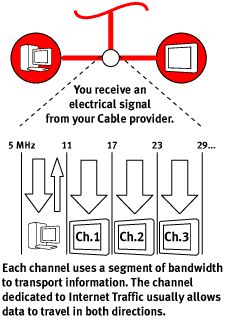What is Cable Internet Access?
 When you get a television signal from your cable company, all of the video and audio information for a particular channel takes up a "slice" of bandwidth. It is possible to take one of these channels and use it for Internet access, and none of the other channels will be affected. Not all cable systems are capable of this, however.
When you get a television signal from your cable company, all of the video and audio information for a particular channel takes up a "slice" of bandwidth. It is possible to take one of these channels and use it for Internet access, and none of the other channels will be affected. Not all cable systems are capable of this, however.
Cable companies take a slice of bandwidth and use it to exchange data with your computer. They divide this channel into two subchannels for upstream and downstream data. ("Upstream" means data going from your computer to the cable company, "downstream" is information coming from the cable company.) They expect a lot more downstream data, because most people download a lot more than they upload. In some cases, cable companies can only send data through the cable, but not receive messages from you. If this is the case, you need to use a conventional modem to request information, and cable companies send it to you at high speed through the cable system.
Are there limitations of cable Internet access?
Depending on how your local cable connection is configured, other cable Internet users in your neighborhood may be able to access your files! You should use always use a firewall, but you especially need to run one when you have a cable modem. A firewall is software that monitors network traffic and prevents unauthorized users from accessing your computer. Firewall software can be downloaded and run on a computer itself, or it can be built into a router. For more about firewalls and routers, read the networking education section.
How do I get Cable Internet Access?
Call your local cable provider and ask if cable Internet access is available.